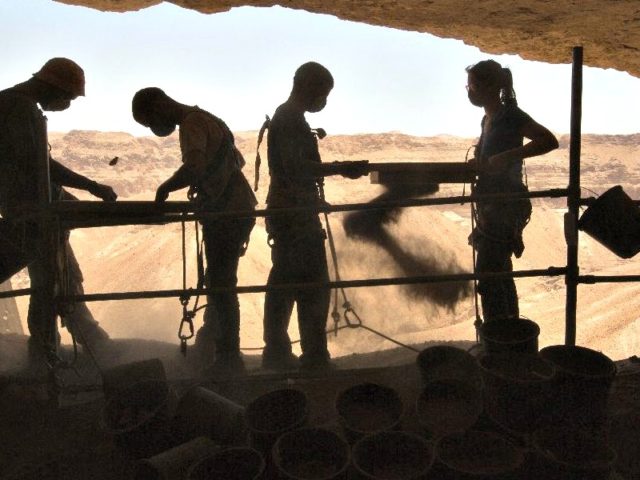TZEELIM CANYON (Israel) (AFP) – It may be the world’s most unusual anti-theft operation, set in a cave high above a desert canyon, the blue of the Dead Sea visible in the distance.
Israeli authorities have been at work at the site, believed to have been used by ancient refugees, seeking to rescue important archaeological remains — possibly including the next Dead Sea Scrolls.
The aim is to do so before the artefacts are looted, a real threat that has occurred in the past.
That means deploying teams of archaeologists and ragtag bands of volunteers who descend about 80 metres (260 feet) down a cliff with the help of ropes to what is known as the Cave of the Skulls, the Tzeelim Canyon plunging below.
Some then crawl inside the recesses of the limestone cave on their hands and knees, headlamps shining in the darkness, and scoop rock and dirt into buckets that are carried back to the entrance.
Standing close to the ledge, the stunning view of the canyon and Dead Sea behind them, volunteers sift the buckets’ contents, so far finding items such as pieces of jawbone, ancient rope, a piece of carved wood and a potentially important piece of papyrus.
“Beats going to work,” said one volunteer, 39-year-old electrical engineer Guy Raveh, as he knelt in a narrow passageway and shovelled dirt into a bucket.
“This is the allowance I got from home — from the wife and the kids,” the father of four boys from the Israeli village of Mevo Beitar said.
Hai Ashkenazi, a 46-year-old finishing up his archaeology Ph.D. at Tel Aviv University, held a just discovered carved stick that may be as old as the Chalcolithic Age.
“For me, it’s fascinating to hold something people used 6,000 years ago,” he said, standing near the cave entrance and overseeing the squad of volunteers, thick clouds of dirt forming in the air due to buckets being emptied.
– Undercover operation –
The project at the cave in the Judean Desert began three weeks ago and wraps up on Thursday, with the Israel Antiquities Authority (IAA) hoping to extend it to more locations.
The Cave of the Skulls, given the name because seven ancient skulls were found there around 1960, has been singled out because it has been the site of looting in the past.
It is one of the numerous caves in the Dea Sea area, with many of what have come to be known as the Dead Sea Scrolls discovered further north in the area of Qumran, in the occupied West Bank.
Israeli archaeologists believe the Cave of the Skulls was used by Jewish refugees during the destruction of the Second Temple in Jerusalem by the Romans around 70 AD, as well as during the Bar Kokhba revolt of Jews against the Romans around 65 years later.
It was also used by humans in earlier eras, and the cave’s dry, cool conditions mean that the remnants inside have been well-preserved, said Amir Ganor, head of the IAA’s robbery prevention unit.
– ‘Vacation for nerds’ –
In 2009, during an undercover operation, Israeli authorities discovered that a looted papyrus was for sale on the black market with Hebrew writing, a form of contract believed to date back to the years following the Bar Kokhba revolt or possibly before.
It was being sold for $2 million, the authority says, and undercover agents were able to pose as buyers, eventually carrying out arrests and seizing the papyrus.
The papyrus was said to have been taken from the Tzeelim Canyon, and investigators will now determine whether the piece of papyrus found during the new project is linked.
Later, in 2014, investigators received firm proof of looting at the Cave of the Skulls when robbers were photographed entering it.
They were caught with a comb dating to the Roman era, around 2,000 years ago, and an arrow from the Neolithic period, around 8,000 years old.
“Theft of antiquities is a common phenomenon in Israel,” Ganor said.
“Every year, around 150 thieves are caught, who rob the antiquities sites.”
There are hopes that a history-altering find like the Dead Sea Scrolls will be located at the Cave of the Skulls, but anything that sheds light on the past is welcomed by those managing the project.
In November, Israel is planning to publish part of another letter on papyrus found in the desert, said Ganor, who could not give out further details.
The collection of volunteers who have camped out for three days at a time near the cave runs the gamut from scholars to young people looking for adventure and who responded to calls for help on Facebook.
“For us, this is a vacation for nerds,” said Martin Abegg, a 66-year-old Canadian professor and Dead Sea Scrolls scholar.

COMMENTS
Please let us know if you're having issues with commenting.